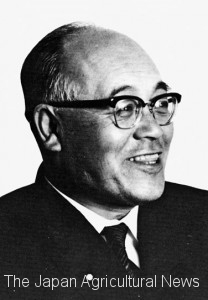Victorious countries presenting the draft

Agriculture Minister Wada (from ” Phantom of the flower, life of Hiroo Wada” Agriculture and Forestry Statistics Publishing Inc.)
Agrarian reform in Japan became an international problem. It went up on the agenda in the Allied Council for Japan which was consist of 4 victorious country and was set to discuss how to proceed with the occupation policy. From April to June of 1946, the council was held in this theme 4 times.
On May 29, representative of the Soviet Union suddenly issued a “Soviet proposal” on the agrarian reform of Japan. “Limit of holding farmland by Resident landlord should be less than 3 ha in general area, and 10 ha only in Hokkaido area. Part exceeding the possession limit should be purchased by the government. In the case of purchase by farmers, the government should assist half of their funds.” On June 12, came also the UK proposal. It was formally the UK proposal, but substantially UK and United States proposal. Because Acheson, representative of US, was chairman and unable to speak. There was an expert, Wolf Ladejinsky, behind.
After that, it came out taiko (general principles) which was based on the UK proposal. For the first time, the taiko (general principles) issued proposal that ” limit of holding tenant farmland by Resident landlord should be less than 1 ha.” The United States jumped to this. The United States was also in trouble unable to find the point of compromise, although it felt “limit of 5 ha is too much.”
The taiko (general principles) also proposed “Limit of holding farmland by Resident landlord should be less than 3 ha in general area, and 12 ha only in Hokkaido area”, ”Direct transactions between landlord and tenant farmer should be stopped”, ”The government should purchase farmland from landlord and sell to tenant farmers through the decision of nogyo-shuyo-iinkai (agricultural land expropriation committee, (nochi-iinkai (farmland Committee) after) ) ,in which the same number of representatives of landlord and tenant farmers participate”. This became the prototype of the second agrarian reform.
Enactment of law under government of Shigeru Yoshida
During the Allied Council for Japan had been held, the regime change was occurred in Japan. On April 10, the general election of the House of Representatives was carried out for the first time after the war. Nihon-jiyuto (Japan Liberal Party) became the first party, and primary Shigeru Yoshida Cabinet was born. Owing to prime minister Yoshida, Hiroo Wada, agricultural policy director, was appointed the agriculture and forestry minister in spite of the objection by the party. In the constitutional history, there had been no example of direct promotion from director to minister. People thought that it appeared to be extremely difficult for Wada, who had no political foundation except for personal confidence of Yoshida, to resolve this challenging matter together with the party and the government.
Allied General Headquarters (GHQ) prepared the command in document in order to promote the pass of the bill. However, MacArthur did not adopt the format of command by GHQ.
He hoped that “agrarian reform should be carried out by planning in the free will of the Japanese government, instead of power of occupation forces because its impact on nation people is so large.” The contents of the memorandum were conveyed verbally to Agriculture Minister Wada.
The Second agrarian reform law (the special measures law for establishment of owner farmer and revised law for adjustment of farmland) was passed through the 90th imperial Diet.
Purchase and selling of farmland proceeded smoothly, and agrarian reform project was finished in 1948. About 1.93million ha of farmland, almost as planned, had been released for establishment of owner farmers. Number of farmers who received the sold farmland was about 4.75 million. The number indicates the size of the social impact.
Compared to the previous situation before the reform, area of tenant farmland, which had occupied 46.3% of the total arable land area, declined to 10.8% of it. Number of owner farmers, which had been only 56.3% of the total farmers, increased up to 87%.
Keiki Owada ( 1915 ~ 1986 ), bureaucrat of the Agricultural policy Division of the Ministry of Agriculture and Forestry at the time, once said “There is a view that agrarian reform has been done by the power of the United States under occupation of the Allied. On the other hand, there is also a view that agriculture world of Japan wanted this, farmers and reform-minded people promoted it. I think that both of them was combined and realized the reform.”(Keiki Owada “Pass down of Showa history “).
Masaaki Ishida, professor of Ryukoku University, in his book, “History of JA and our role”(Ienohikarikyokai), analyzed and claimed “agrarian reform meant their farmland, which tenant farmer had been cultivated for long time from Edo period, returned to their hand from the hand of landlord. The reform revived the system to own and cultivate the ancestral land again, without owing and cultivating unknown farmland. ”
Reference = Keiki Owada “The Secret History, Japanese agrarian reform” the Nihon Keizai Shimbun, Motochika Mitsukawa “The post-war agriculture organization development history” Meibun Shobo, Keisuke Otake ” Phantom of the flower, life of Hiroo Wada” Agriculture and Forestry Statistics Publishing Inc., Masaaki Ishida “History of JA and our role” Ienohikarikyokai, Asahi bunko “Pass down of Showa history 3″ Asahi newspaper Publishing Inc.

